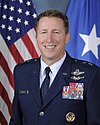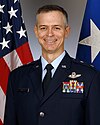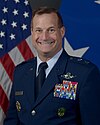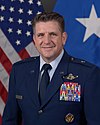Nineteenth Air Force
| Nineteenth Air Force | |
|---|---|
Major General Clark Quinn | |
| Notable commanders | Maj Gen "Michael A. Keltz". Brig. Gen. Henry Viccellio, 8 July 1955 – June, 1960, July 1963 – June 1964 Major General Mark S. Solo[3] Maj Gen William E. Bryan Jr.[4] |
The Nineteenth Air Force (19 AF) is an active Numbered Air Force of the United States Air Force. During the Cold War it was a component of Tactical Air Command, with a mission of command and control over deployed USAF forces in support of United States foreign policy initiatives. The command was reactivated in 1993 under Air Education and Training Command with a mission of conducting AETC's flying training.
19th Air Force was inactivated on 9 July 2012 as a cost-cutting measure by the Secretary of the Air Force, but was reactivated on 1 October 2014 when it was determined that the cost-cutting measures did not reap the savings expected. AETC commander General Robin Rand directed the reactivation to consolidate the management of the AETC flying mission again under a Numbered Air Force instead of the AETC Headquarters.
History
Cold War
Origins
In the aftermath of the Korean War in 1953, the United States Air Force began to institutionalize a quick response force to deploy personnel, aircraft and equipment to bases with minimal facilities and to develop an air refueling capacity for its fighter aircraft.[5]
From this initiatives,
On 8 July 1955, under the command of Brig. Gen. Henry Viccellio, TAC activated the command element of the CASF, the Nineteenth Air Force.
Structure

The headquarters of the Nineteenth Air Force was considered one of the most unusual HQs the U.S. Air Force created at the time. It had no permanently assigned aircraft or combat units. Nor did it have, since it was an operational headquarters only, any units or bases to supervise, train, or inspect. When not deployed, the Nineteenth had a close working relationship with the Ninth Air Force, which supported its administrative functions with many of its own people. These circumstances allowed the Nineteenth to limit its staff to approximately 85 military and 6 civilian personnel.[5]
The mission of Nineteenth Air Force was to prepare contingency plans for and to command short-notice deployments of the CASF anywhere in the world. It required each individual member to be ready for instant departure from the United States, and its staff sections maintained 30-day flyaway kits prepared for shipment. The Nineteenth worked closely with
The plans section would lead Europe and Middle Eastern deployments; the operations section would lead those to the Pacific; and the logistics section would lead deployments to Latin America, the Caribbean, and Africa. This unique arrangement allowed for continuity of planning and expertise and helped overcome some of the disadvantages inherent in the U.S. armed forces policy of churning personnel through different assignments every three or so years. Within the service, the Nineteenth soon earned its nickname: The Suitcase Air Force.[5]
In keeping with its mission of deterrence, a CASF, in theory, consisted of three task forces, each of which could vary in size and composition, according to its assigned task.
- The first task force had only a limited combat capability and consisted of a show-the-flag or a good-will package. It could fulfill the role of gunboat diplomacy. A force such as this went to Turkey, Iran, and Pakistan (Operation Quick Span) in February 1960.[5]
- The second task force consisted of the basic CASF combat element and would serve as the initial force for a small war. TAC kept the units of the second task force on a progressive 24-hour alert system and planned for the first portion to move within four hours of alert and the entire force to deploy in 24 hours.[5]
- The third task force, composed of additional fighter squadrons, would augment the second if the situation required an expanded force.[5]
1958 Lebanon Crisis
On 15 July 1958, President
To support the Marines, the National Command Authorities (NCA) alerted the CASF. Under the command of Maj. Gen. Henry Viccellio, within three hours,
1958 Taiwan Straits Crisis
Because the entire Nineteenth Air Force headquarters had deployed to Lebanon, TAC ordered its
The United States responded by supplying the Nationalists with tanks and new heavy and longer-ranged artillery as well as by beefing up its own forces in the region. TAC placed on alert a squadron of F–100s; transport aircraft loaded with supplies, parts, and equipment; and a communications and control squadron. It also began to "lean forward", sending tankers, weathermen, maintenance crews, and control units to islands on the air route between California and
Late on 29 August 1958, the second CASF received the "go" order. F–100s from the
1962 Cuban Missile Crisis
In mid-October 1962, the Nineteenth moved from its home base, Seymour Johnson AFB, North Carolina, to
Other missions
In September 1962, when racial tension over the integration of the state university in Oxford, Mississippi, caused the federal government to send in troops, personnel of the Nineteenth coordinated airlift activities.[5]
In 1963 Nineteenth Air Force conducted two show-the-flag exercises. The first went to Saudi Arabia in early May. There, the Nineteenth helped to train Saudi pilots and supervised a tactical demonstration at Jidda International Airport for 30,000 spectators that included Crown Prince Faisal, the Prime Minister, the Saudi Foreign Minister, and other royalty and officials.[5]
The second went to India in October. There, in Exercise Shiksha (Sanskrit for training), the Nineteenth, in cooperation with the British and Australian Royal Air Forces, helped to improve Indian Air Force air defense capabilities and provide other tactical training. This effort was partially in response to the earlier division-sized Sino-Indian conflict. Throughout its existence, the Nineteenth also participated in numerous joint exercises within the United States as well as in practice alerts.[5]
For practical purposes, the Vietnam War ended the work of the Nineteenth Air Force, as that conflict absorbed a large proportion of the USAF’s assets not directly dedicated to the nuclear deterrent and consequently lessened the nation’s ability to intervene in other crisis areas. At the beginning of the Vietnam War, a CASF deployed in response to the Tonkin Gulf incidents, and in 1968 the last CASF deployment came in support of American forces in the Republic of Korea during the USS Pueblo incident.[5]
Legacy
The Nineteenth Air Force was inactivated in July 1973, as part of the economies enacted after the end of the
Air Education and Training Command
As a part of the realignment and re-organization of the Air Force after the end of the
Air Force pilot candidates began with introductory flight training (IFT). In IFT, civilian instructors provided 50 hours of flight instruction to pilot candidates who completed requirements for a private pilot license. Upon graduation, pilot candidates then attended either Euro-NATO joint jet pilot training (ENJJPT) or joint specialized undergraduate pilot training (JSUPT).[6]
- ENJJPT is located at T-38 Talon and continue building the skills necessary to become a fighter pilot.[6]
- JSUPT students accomplish primary training in the T-34C Turbomentor at Naval Air Station Whiting Field, Florida. Joint training is conducted at Vance AFB, and NAS Whiting Field for students from the Air Force and Navy. During the primary phase of JSUPT, students learn basic flight skills common to all military pilots.[6]
- Prospective airlift and tanker pilots are assigned to the airlift/tanker track and train in the C-130 Hercules.[6]
- Those students selected to fly helicopters are assigned to the helicopter track and fly the Fort Rucker, Alabama.[6]
Nineteenth Air Force also provided follow-on training for most Air Force pilots in their assigned aircraft. Pilots assigned to fighter aircraft complete the introduction to fighter fundamentals course at Randolph AFB or
Aircrews assigned to fly the C-130 train at
Pilots assigned to fly
The Army at Fort Rucker, provides training in the
In addition to pilot training, Nineteenth Air Force provides joint specialized undergraduate navigator training. JSUNT is conducted at Randolph AFB and
Students at NAS Pensacola, complete primary and intermediate training in the T-34C and T-1 aircraft, and then enter the one of two tracks in the next phase. Students in the strike track will serve as navigators in the
Nineteenth Air Force also provided enlisted aircrew training for a wide variety of aircrew specialties including flight engineers, air-to-air refueling boom operators, loadmasters, aerial gunners, airborne communications specialists and weapons directors. Flight engineers and boom operators train at Altus AFB, loadmasters train at Sheppard AFB, helicopter flight engineers and aerial gunners train at Kirtland AFB, airborne communications specialists train at Keesler AFB, and Air Battle Managers train at Tyndall AFB.[6]
As a cost-cutting measure, Nineteenth Air Force was inactivated on 9 July 2012. An inactivation ceremony was held for the 19th Air Force at Joint Base San Antonio, Texas.[7]
Lineage
- Established as Nineteenth Air Force on 1 July 1955
- Activated on 8 July 1955
- Inactivated on 2 July 1973
- Re-activated on 1 July 1993
- Inactivated on 13 July 2012
- Re-activated on 1 October 2014
Assignments
- Tactical Air Command*, 8 July 1955 – 2 July 1973
- Attached to: Ninth Air Force, 8 July 1955 – 30 June 1957
- Air Education and Training Command, 8 June 1993 – 9 July 2012, 1 October 2014–
Note: In its first two years, Nineteenth Air Force was directly attached to Ninth Air Force. On 1 July 1957 it moved to the direct control of TAC headquarters but it maintained its working relationship with the Ninth Air Force, whose support enabled the Nineteenth to retain its small footprint
Stations
- Foster AFB, Texas, 8 July 1955
- Seymour Johnson AFB, North Carolina, 1 September 1958 – 2 July 1973
- Randolph AFB, Texas, 8 June 1993 – 9 July 2012, 1 October 2014 – Present
AETC Components
|
|
List of commanders
| No. | Commander | Term | |||
|---|---|---|---|---|---|
| Portrait | Name | Took office | Left office | Term length | |
| 1 | Major General Michael A. Keltz | 1 October 2014 | 23 June 2015 | 265 days | |
| 2 | Major General James Hecker | 23 June 2015 | 28 March 2017 | 1 year, 278 days | |
| 3 | Major General Patrick J. Doherty | 28 March 2017 | 13 June 2019 | 2 years, 77 days | |
| 4 | Major General Craig D. Wills | 13 June 2019 | 19 August 2022 | 3 years, 67 days | |
| 5 | Major General Phillip A. Stewart | 19 August 2022 | 10 May 2023 | 264 days | |
| - | Brigadier General Christopher R. Amrhein Acting | 10 May 2023 | 5 June 2023 | 26 days | |
| 6 | Major General Clark Quinn | 5 June 2023 | Incumbent | 318 days | |
References
![]() This article incorporates public domain material from the Air Force Historical Research Agency
This article incorporates public domain material from the Air Force Historical Research Agency
- ^ "Nineteenth Air Force (AETC)". af.mil. Archived from the original on 1 May 2018. Retrieved 1 May 2018.
- ^ "Air Education and Training Command > Units > 19th Air Force". www.aetc.af.mil. Archived from the original on 28 September 2017. Retrieved 1 May 2018.
- ^ [1] Archived 13 April 2010 at the Wayback Machine
- ^ "Major General William E. Bryan Jr". af.mil. Retrieved 21 March 2022.
- ^ a b c d e f g h i j k l m n o p q r s "Air Force Historical Support Division > Home" (PDF). www.afhso.af.mil. Archived (PDF) from the original on 23 November 2016. Retrieved 1 May 2018.
- ^ a b c d e f g h i j k l m n 19th Air Force Official factsheet Archived 3 August 2008 at the Wayback Machine
- ^ Inactivation ceremony for 19th Air Force scheduled July 12 Archived 24 February 2013 at the Wayback Machine. Vance.af.mil. Retrieved on 2014-05-24.










